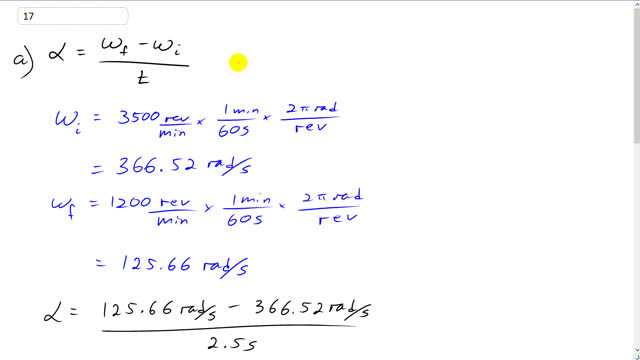
An automobile engine slows down from 3500 rpm to 1200 rpm in 2.5 s. Calculate
- its angular acceleration, assumed constant, and
- the total number of revolutions the engine makes in this time.

In order to watch this solution you need to have a subscription.
This is Giancoli Answers with Mr. Dychko. The angular acceleration of this automobile engine is gonna be the final angular velocity minus the initial angular velocity divided by the time it takes to change those angular velocities. So initially it's going at 3500 revolutions per minute and we'll have to convert that into radians per second in order to use it in this formula and we'll multiply by 1 minute for every 60 seconds then times by 2π radians for every revolution and we get 366.52 radians per second is the initial velocity. And it slows down to a final angular velocity of 1200 revolutions per minute so we multiply 1200 by 2π radians for every revolution and divide by 60 seconds here and then the minutes cancel leaving us with seconds on the bottom so we have 125.66 radians per second for the final angular velocity. So we take the final minus the initial and divide by 2.5 seconds and we get negative 96 radians per second squared is the angular acceleration. The total angular displacement is the average angular velocity multiplied by time so we add these two angular velocities in radians per second that we found before divide by 2, multiply it by 2.5 seconds this gives us total angular displacement of 615.225 radians. To find the number of revolutions, we multiply those radians by 1 revolution for every 2π radians and the radians cancel leaving us with 98 revolutions approximately. So we are taking this number and dividing by 2π and getting 98 revolutions.
where did you derive the equation for part b when solving the number of revolutions